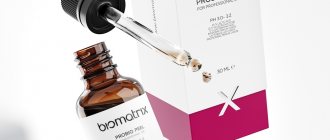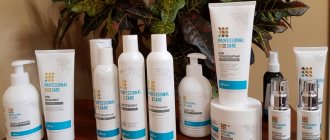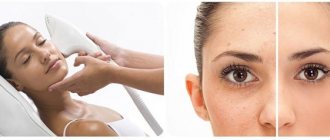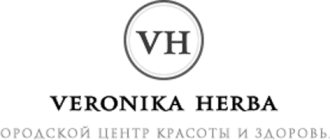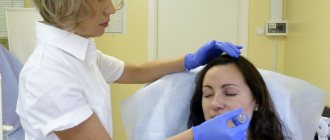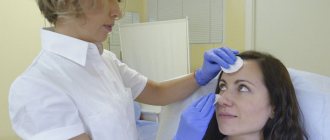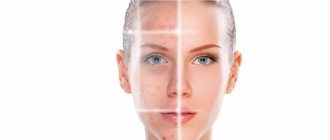Yulia Prokopenko, leading technologist-expert
educational
Expert opinion
Many cosmetologists are afraid to sell home care to clients. They are shy, don’t know what to do, and don’t want to be intrusive. The reason is the wrong approach. Your task is not to force a person to buy, but to help him keep his skin healthy at home. Just keep this in mind, and we’ll tell you about the rest of the nuances of additional sales in the article.
Yulia Prokopenko, leading technologist-expert
educational
Chemical peeling with acids is one of the main and most effective tools in a cosmetologist’s arsenal. Peels are included in almost every facial care program at the deep cleansing stage and help solve many skin problems: from acne and oiliness to wrinkles and pigmentation.
Chemical peels speed up the skin renewal process. This occurs due to exfoliation: in this case, peeling dissolves dead cells of the upper stratum corneum of the skin or destroys the connection between cells. The action of some peels stimulates cell division, and skin renewal occurs due to this.
The peeling procedure is usually used for the face, but can also be indicated for treating the neck, décolleté, hands, and problem areas on the body (for example, to reduce stretch marks).
Peeling-biorevitalizant for all skin types Anti-Age Renew Biopeel, 100 ml
Peeling-biorevitalizant for mature skin Lifting Renew Biopeel, 100 ml
Peeling-biorevitalizant for oily and problem skin Anti-Acne Renew Biopeel, 100 ml
Contraindications to the use of peelings
Despite the fact that light all-season peeling can be performed without restrictions on the time of year, it is important to take into account the state of the body and diseases in which intensive effects on the skin are contraindicated.
Absolute contraindications:
- individual intolerance to peeling ingredients;
- violation of the integrity of the skin;
- active infectious process on the skin (herpetic rashes, papillomas, etc.);
- psoriasis;
- atopic dermatitis;
- tendency to form keloid scars;
- severe somatic diseases;
- pregnancy and lactation.
Relative contraindications:
- taking medications that have a photosensitizing effect;
- taking retinoids;
- taking immunosuppressants;
- history of poor wound healing;
- mental disorders.
Yulia Prokopenko, leading technologist-expert
educational
Expert opinion
Acid peels are prohibited for severe rosacea. At the initial stage of rosacea, gentle superficial types of peeling are allowed, in which acids are used in a minimum concentration.
Yulia Prokopenko, leading technologist-expert
educational
Differences between professional peelings and peelings for home use ↑
The peeling procedure is one of the most sought-after and popular services in beauty salons and cosmetology clinics. And this is despite the fact that the beauty market offers a huge number of peelings for home use and other acid-based products. What is the advantage of salon peeling over home peeling?
Peels for professional use
contain active substances in higher concentrations. This significantly increases the effectiveness of the procedure, but also increases the risk of side effects if used incorrectly. That is why the procedure should be carried out by a specialist trained in working with peelings of a particular brand. In addition, the cosmetologist will select post-procedure care for you.
If the aesthetic imperfections of your skin are minor, peeling yourself can help. However, in some situations, a low concentration of active substances is not enough. Yes, home peelings
are unable to radically solve the problem of strong pigmentation, acne, pronounced wrinkles - this requires potent agents.
Yulia Prokopenko, leading technologist-expert
educational
Expert opinion
With regular use of home peels, the overall quality of the skin will improve, but professional procedures still provide a faster and more obvious effect.
The ideal option is to take a professional peeling course and, with the help of a cosmetologist, choose a home peeling that you can use to maintain the effect yourself, at any time of the year.
Yulia Prokopenko, leading technologist-expert
educational
Rehabilitation
After chemical peels, you need to take good care of your skin to give it a chance to recover. First of all, hydration is necessary. It is recommended to use products with hyaluronic acid, panthenol, aloe and vitamins. In addition, you should avoid any aggressive procedures, the use of alcohol-containing cosmetics, retinoids, and mechanical scrubs. When crusts appear, you cannot remove them yourself - you should be patient and wait until they fall off spontaneously.
It is extremely important to protect your face from ultraviolet radiation. The renewed epidermis is especially sensitive to such effects, so the risk of age spots increases. So the use of protective lotions with a high SPF factor is mandatory not only in the summer (when peeling is generally not recommended), but also in the winter.
To maintain the effect, your doctor may recommend using special cosmetics containing acids. They can be included in creams for everyday use in low concentrations sufficient to preserve the results for a long time.
After superficial treatment, the skin is restored quickly, however, during the entire course and two weeks after its completion, careful care and avoidance of any aggressive influence are necessary.
How the procedure works ↑
The protocol for each type of peeling usually differs in two or three points. However, the general algorithm of actions includes the following steps.
- Pre-peeling preparation.
The stage begins 1-2 weeks before the procedure and consists of skin care using special products selected by a cosmetologist. Preparation helps ensure that the result is as effective as possible. - Skin cleansing.
Immediately before applying the peeling composition, the cosmetologist cleanses the skin of makeup, excess sebum and impurities. - Peeling.
The specialist applies a peeling solution to the required area. The product is kept for a certain time (“exposure time”). - Post-peel preparation.
Apply after exposure time has expired. The drug neutralizes acids, moisturizes and soothes the skin. - The final stage.
A special composition is applied to the facial skin, which accelerates the regeneration of skin cells.
After the procedure, the cosmetologist gives detailed instructions regarding home care and names the approximate date of the next session.
Yulia Prokopenko, leading technologist-expert
educational
Expert opinion
The predicted consequences of the procedure include:
- mild itching;
- redness of the treated area;
- peeling;
- formation of protective crusts;
- swelling.
This is an expected reaction of the body, which goes away 3-4 days after the procedure.
Yulia Prokopenko, leading technologist-expert
educational
Recovery period
The duration of recovery after the procedure depends on the depth of acid exposure. So, after superficial peeling, recovery will take several days, after medium peeling – up to 14 days. Skin regeneration processes after deep peeling require more time - up to six months.
Regardless of the type of peeling and the duration of the recovery period, it is important to take care of your facial skin and follow your doctor’s recommendations. There are few restrictions during this period, but it is highly advisable to comply with them; first of all, it is to refrain from visiting the bathhouse, sauna and, of course, the solarium. Protecting the skin from ultraviolet rays, even in winter, is also the main rule during the recovery period. It is recommended to drink plenty of fluids and touch your face as little as possible.
In addition to generally accepted restrictions, there may be individual ones, which are prescribed by a cosmetologist. A professional specialist will also give recommendations on the use of skincare and decorative cosmetics during the recovery period after the procedure.
Types of peelings by depth of exposure and their effect ↑
Chemical peels are traditionally classified by depth of effect. The higher the pH and concentration of active substances in the peeling, the deeper it penetrates into the tissue.
Superficial peeling
Acts on the top layer of skin. With proper post-procedural care, it does not require a long recovery period. It is considered the softest, because the concentration of acids in superficial peels does not exceed 20%. They are used to improve skin color, restore freshness, restore radiance, and mattify the effect.
Superficial-medium peeling
Preparations for superficial-medium peeling contain acids in higher concentrations than in superficial peeling. This ensures deeper penetration of the active ingredients into the skin. Peeling of this type has a rejuvenating, smoothing, brightening effect, and also normalizes the functioning of the sebaceous glands.
Medium peeling
Affects the epidermis without affecting the basement membrane. Effectively eliminates shallow wrinkles, post-acne and other aesthetic imperfections of the skin, and also fights age-related changes. After such peeling, redness, swelling, and peeling appear on the face, and therefore the rehabilitation period increases to 7 days.
Azelaic
Exfoliation with azelaic acid (carboxylic acid) is allowed for patients who have dermatological diseases (rosacea, rosacea, demodex). Carbon peeling not only gently exfoliates the upper stratum corneum of the epidermis, but also alleviates skin diseases.
Azelaic acid has an anti-inflammatory effect and inhibits the growth of melanocytes. Regular azelaine peeling can significantly reduce pigmentation. The acid normalizes the secretion of the sebaceous glands and has an antibacterial effect without causing resistance in microorganisms. It whitens the skin, making acne and scars less noticeable.
Azelaine peeling is used as a preparatory step before medium and deep exfoliation.
However, azelaic chemical peeling, the types of which differ in the method of using carboxylic acid, can have not only a superficial effect. During the Krulig procedure, the horny scales are not exfoliated, but are dehydrated with azelaic acid. They are removed from the face in the form of a film. Krulig peeling allows you to remove almost the entire epidermis, providing the effect that is observed after medial exfoliation. At the same time, the Krulig procedure is safer.
What acids are used in peelings ↑
AHA acids
These are water-soluble acids and work better on the surface of the skin. Used to eliminate pigmentation (freckles, age spots). Most suitable for those with normal, dry or sun damaged skin. The names of alpha hydroxy acids reflect the primary natural source in which the substance was found.
ANA acids include:
- lactic acid - it is obtained from milk;
- mandelic acid - isolated from bitter almond extract;
- citric acid - from oranges and lemons;
- tartaric acid - from wine waste, grapes, oranges, potatoes, cucumbers;
- malic acid - from apples and pears;
- pyruvic acid - from fruits, honey, vinegar, as well as tartaric and lactic acids;
- glycolic acid - from sugar cane.
BHA acids
These include salicylic acid, isolated from willow bark or an aspirin derivative. Salicylic acid is fat-soluble, so it penetrates deeper into the skin, can exfoliate the surface layer of the skin, and also penetrate the pores (it dissolves in the fat layer). Therefore, it is more preferable for combination and oily skin, prone to the formation of inflammatory elements and clogged pores.
PHA acids
These are two acids: gluconic and lactobionic. Gluconic acid is produced naturally in skin cells in small quantities and is produced in the laboratory by fermenting pure glucose. Lactobionic acid consists of the sugar galactose and gluconic acid.
The peculiarity of PHA acids is the large size of the molecules, which do not penetrate deeply and work only on the surface of the stratum corneum. Their effect is more delicate and not as deep, so products with PHA are safe for sensitive, reactive skin.
Peels from ARAVIA Professional: professional approach ↑
ARAVIA Professional chemical peels are designed to correct aesthetic skin imperfections as part of complex procedures in beauty salons. These are strictly professional preparations - they are intended for specialists who can determine the skin's reaction to acid and guarantee the safety of the procedure.
Yulia Prokopenko, leading technologist-expert
educational
Expert opinion
Line of multi-acid peelings MG Peel System
has long established itself among cosmetologists and their patients, and the Renew Biopeel line of biorevitalizing peelings is an absolute novelty..
Yulia Prokopenko, leading technologist-expert
educational
Biorevitalization peelings combine the best of two professional procedures: peeling and biorevitalization. Their main feature is their composition. In addition to acids, they contain low molecular weight hyaluronic acid and a powerful active ingredient with a revitalizing effect.
Hyaluronic acid is a biopolymer that is synthesized in the body. As an essential compound, it is found in joints and connective tissue, skin and tissues of the nervous system. With age, its amount decreases, which leads to loss of elasticity, dull skin color, dryness, and the appearance of wrinkles.
Benefits of low molecular weight hyaluronic acid:
- deeper penetration into the layers of the skin;
- powerful moisturizing effect on all layers of the skin, including the reticular dermis;
- stimulates fibroblasts to produce their own glycosaminoglycans;
- binds H2O in the intercellular space, significantly increasing tissue elasticity;
- retains moisture in the epidermis, due to which signs of fatigue, wrinkles and crow's feet disappear.
Peeling-biorevitalizant for oily and problem skin ANTI-ACNE RENEW BIOPEEL
Professional peeling of a new generation with a biorevitalization effect based on a complex of AHA acids (tartaric, glycolic, lactic, malic, almond, citric) and hyaluronic acid. Designed to meet the needs of oily and problematic skin, prone to acne, comedones and enlarged pores, dull complexion, and post-acne elements.
Features: pH 1.5. Acid concentration - 40%.
Indications:
- acne;
- seborrhea;
- post-acne;
- seborrheic keratosis;
- violation of skin microrelief;
- hyperpigmentation;
- enlarged pores.
Effect:
- deep cleansing;
- color alignment;
- reduction of hyperkeratosis;
- sebostatic effect;
- acceleration of resolution of inflammatory elements;
- getting rid of acne marks;
- prolonged hydration.
Peeling-biorevitalizant for mature skin LIFTING RENEW BIOPEEL
Professional peeling of a new generation with a biorevitalizing effect based on lactic acid, hyaluronic acid and DMAE (dimethylaminoethanol). Designed for aging mature skin with visible signs of aging, decreased tone, sagging, dull color, age-related pigmentation and fine wrinkles.
DMAE (dimethylaminoethanol) is an analogue of choline, a B vitamin, a precursor of acetylcholine. It is found in a natural form in the human body. With age, the volume of DMAE in the body decreases, and it becomes necessary to supply it from outside. DMAE promotes the production of acetylcholine, which tightens sagging muscles and skin. Improves blood circulation, helping to fight wrinkles, dryness and swelling from the inside. Protects cells from aging and free radicals.
Features: pH 2.0. Acid concentration - 40%.
Indications:
- age-related changes;
- deterioration of complexion;
- the presence of age spots and other signs of photoaging;
- loss of skin turgor and elasticity;
- hyperkeratosis;
- gravitational ptosis.
Effect:
- prolonged skin hydration;
- activation of regeneration and rejuvenation processes;
- increased turgor and elasticity;
- reducing the depth of wrinkles;
- visible lifting effect;
- even out complexion.
